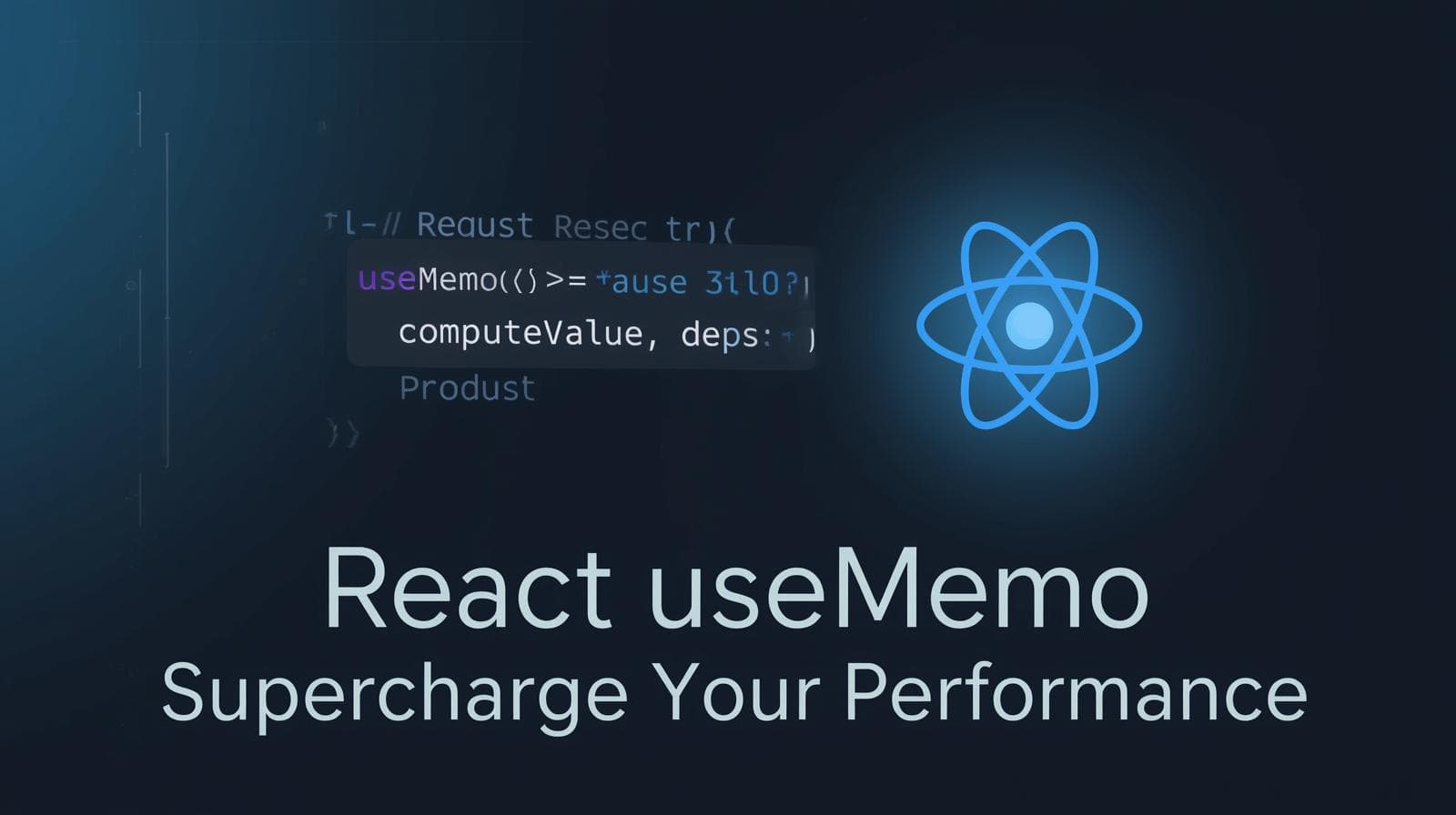Master React's useEffect Hook: A Complete Guide with Examples & Best Practices

Confused by React's useEffect? This in-depth guide explains what it is, how it works, with real-world use cases, best practices, and FAQs to level up your React skills.

Master React's useEffect Hook: A Complete Guide with Examples & Best Practices
Taming Side Effects: Your Definitive Guide to React's useEffect Hook
If you've been working with React functional components, you've almost certainly encountered a situation where you needed to "do something" after your component rendered. Maybe it's fetching data from an API, setting up a subscription, or manually changing the DOM. In the class-based component era, lifecycle methods like componentDidMount, componentDidUpdate, and componentWillUnmount were the go-to solutions.
But in the world of Hooks, one powerful tool reigns supreme for these tasks: useEffect.
If you've found yourself scratching your head, wondering why your effect runs too often, or not at all, you're not alone. useEffect is incredibly flexible, but that flexibility comes with a learning curve. This guide is designed to flatten that curve. We'll dive deep into what useEffect is, how it works, and how to use it like a pro.
What Exactly is useEffect?
In simple terms, useEffect is a Hook that lets you perform "side effects" in your functional components.
Hold on. "Side effects"? That sounds complicated. Let's simplify it.
A side effect is any operation that interacts with the outside world, outside of the predictable world of React's render cycle. Think of your component as a pure function: it takes props and state, and returns JSX. A side effect is something that happens on the side. Here are the most common examples:
Data Fetching: Getting user data, posts, or any information from an API.
Direct DOM Manipulation: Changing an element's style, focusing an input field, etc.
Subscriptions: Setting up a listener for a WebSocket, Firebase, or any external event.
Timers: Using
setIntervalorsetTimeout.
useEffect is your gateway to handling all these operations in a declarative way, seamlessly tying them into your component's lifecycle.
The Basic Syntax
The useEffect Hook takes two arguments:
A function (the "effect" itself) that contains the side effect logic.
An optional array of dependencies that tells React when to run your effect.
javascript
import { useEffect } from 'react';
function MyComponent() {
useEffect(() => {
// This is your side effect logic.
// It runs after the component has rendered.
// Optional: You can return a "cleanup function"
return () => {
// This runs when the component unmounts OR before the effect re-runs.
};
}, [dependency1, dependency2]); // The dependency array
return <div>// ... JSX ...</div>;
}How useEffect Works: A Practical Deep Dive
The magic of useEffect is controlled by its dependency array. Let's break down the most common patterns.
1. Running on Every Render (No Dependency Array)
If you omit the second argument, the effect runs after every single render of your component.
javascript
useEffect(() => {
console.log('I run every time this component renders!');
});Use Case: This is rarely what you want. It can lead to performance issues and infinite loops if you update state inside it. Use with caution!
2. Running Only Once on Mount (Empty Dependency Array)
Providing an empty array [] tells React that your effect has no dependencies. This means it will only run once, after the initial render—mimicking componentDidMount.
javascript
useEffect(() => {
// Perfect for one-time operations like initial data fetching.
const fetchUserData = async () => {
const data = await fetch('/api/user');
setUser(data);
};
fetchUserData();
}, []); // Empty array = run once on mountReal-World Use Case: This is the classic place for fetching initial data when a page or component loads.
3. Running When Specific Values Change
This is where useEffect becomes incredibly powerful. By putting variables (props or state) in the dependency array, you tell React to re-run the effect only when those specific variables change.
javascript
function UserProfile({ userId }) {
const [user, setUser] = useState(null);
useEffect(() => {
// Fetch user data whenever the `userId` prop changes.
const fetchUser = async () => {
const data = await fetch(`/api/users/${userId}`);
setUser(data);
};
fetchUser();
}, [userId]); // Effect depends on the `userId` prop
return <div>{user ? user.name : 'Loading...'}</div>;
}Real-World Use Case: Imagine a dashboard where selecting a different customer from a dropdown (customerId changes) should refetch and display that customer's orders. This pattern is perfect for that.
The Crucial Cleanup Function
Some side effects need to be "cleaned up" to prevent memory leaks. For example, if you set up a subscription or a timer, you need to tear it down when the component unmounts. This is what the cleanup function is for.
You return a function from inside your effect, and React will run it at the right time.
javascript
useEffect(() => {
// Set up a timer
const intervalId = setInterval(() => {
console.log('Tick!');
}, 1000);
// Set up a WebSocket connection
const socket = new WebSocket('ws://localhost:8080');
// Return the CLEANUP function
return () => {
clearInterval(intervalId); // Clean up the timer
socket.close(); // Close the WebSocket
};
}, []);In this example, when the component unmounts, React will call the cleanup function, ensuring our interval and WebSocket don't keep running in the background.
Best Practices and Common Pitfalls
Using useEffect effectively means avoiding common mistakes.
Don't Ignore the Dependency Array. ESLint rules will warn you about missing dependencies. Heed them! If you see a linter warning, don't just ignore it or remove the dependency. Think about why that variable is needed. If you truly need to skip it, you can, but do so intentionally.
Handle Async Functions Correctly. You cannot make the effect callback itself an
asyncfunction. Instead, define an async function inside and call it.javascript
// ✅ Correct useEffect(() => { const fetchData = async () => { const result = await axios.get('/api/data'); setData(result.data); }; fetchData(); }, []); // ❌ Incorrect useEffect(async () => { const result = await axios.get('/api/data'); setData(result.data); }, []);Use Multiple Effects for Separate Concerns. Don't cram unrelated logic into a single
useEffect. Split them up. This makes your code easier to understand and test.javascript
// Good: Separate concerns useEffect(() => { // Data fetching logic }, [userId]); useEffect(() => { // DOM event listener logic }, []);
Frequently Asked Questions (FAQs)
Q: Can I use useEffect for state updates on mount?
A: Yes, but be careful. If you update state based on props or other state, consider using useState with a function for the initial state instead, or be mindful of the dependencies.
Q: Why is my useEffect stuck in an infinite loop?
A: The most common cause is updating a state variable that is also in the dependency array, without a condition to prevent it. For example, useEffect(() => { setCount(count + 1); }, [count]); will run forever. You need a condition to stop the update.
Q: How do I skip an effect on the initial render?
A: You can use a useRef to track if it's the first render.javascript const isFirstRender = useRef(true); useEffect(() => { if (isFirstRender.current) { isFirstRender.current = false; return; } // Your effect logic here, which skips the first render }, [someDependency]);
Conclusion: useEffect is Your Powerful Ally
The useEffect Hook is a cornerstone of modern React development. It elegantly consolidates what previously required three different lifecycle methods. By understanding its dependency array and cleanup mechanism, you can handle any side effect with confidence and write components that are robust, efficient, and free of memory leaks.
Mastering Hooks like useEffect is a fundamental step on the path to becoming a proficient React developer. It unlocks the full potential of functional components and leads to cleaner, more maintainable code.
Ready to build a rock-solid foundation in modern web development? This deep understanding of core concepts is what we instill in every student at CoderCrafter. To learn professional software development courses such as Python Programming, Full Stack Development, and the MERN Stack, visit and enroll today at codercrafter.in. Transform your coding skills and build your future, one Hook at a time!









